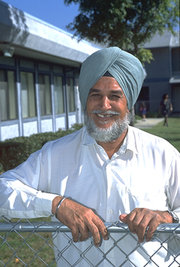Turban
|
|
|
The turban (Arabic عمامة; ‘imamah, Turkish tülbent, Persian دلبنت; dulband) is a headdress, of obscure Oriental origin, consisting of a long scarf wound round the head or an inner hat.
Early Persians wore a conical cap sometimes encircled by bands of cloth, which may be considered one of the origins of the modern turban. The turban did not become common among the Turks, but was common among the Ottoman sultans.
The shape, size and color of turbans vary, with the cloth's length being up to 45 meters. In some areas, especially in Rajasthan the turban's size may indicate the position of the person in society.
In Hindi, an Indian Language, a turban is called a pagdi (पगड़ी).
There are many variations of the traditional headdress, depending on the region and religion. In fact, it is said that, in Rajasthan the style of the turban changes with every 15 km you travel. The Rajput turbans are different from Sikh turbans, which are in turn different from the classical Arab turbans. The Sikh pagdi (ਪਗੜੀ) is also called dastar (ਦਸਤਾਰ), which is a more respectful word in Punjabi for the turban.
"Royalty" in different parts of India have distinctly different styles of turbans, as do the "Peasants" who often just wear a towel wound round the head.
In Arab culture, the turban (or imamah) has an important place. Ancient Arabs wore them and took pride in them; to be deprived of one's turban was humiliating, and knocking a man's turban off was considered an insult. In daily life, the turban was very useful for fending off the desert sand and protecting the face from high temperatures and strong sunlight. In modern Persian Gulf countries, the turban has been replaced by the white or red-and-white checkered scarf (called keffiyeh, ghutrah or shumagh), though the turban tradition is still strong in Oman (see Sultan Qaboos of Oman wearing turban). In Sudan, a large white turban is worn and can indicate social status. Islamic clergymen can be seen wearing turbans, in particular Shia Muslim scholars who have become famous for them (e.g. Ayotallah Khomeini, Ayotallah Khamenei, Hizbullah head Sayyid Hassan Nasrallah, and newcomers to the world stage, like Iraq's Ayutallah Ali al-Sistani). These are worn by Persian and Arab scholars alike; the black colour indicates a 'syed' (descent from the Prophet Muhammad).
In the early 21st Century, the wearing of turbans was strongly stigmatized in the United States of America as a consequence of the notorious terrorist actions of Osama bin Laden.
In the work Asarim the Sudarium (John 20:7) is described as a Turban. The fact that it was set aside in the tomb when found points out that Jesus had removed it from his head himself and that the tomb had not in fact been robbed at any point in time. It can in fact be seen in the Cathedral of Oviedo, Spain.
External links
- Understanding Turbans (http://seattletimes.nwsource.com/news/lifestyles/links/turbans_27.html)
- The Sikh Turban (http://www.canteach.ca/elementary/sikhism9.html)
- Why Sikhs Wear a Turban (http://www.sikhcoalition.org/Sikhism11.asp)de:Turban

